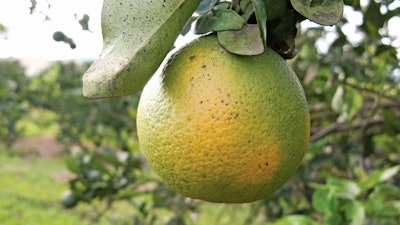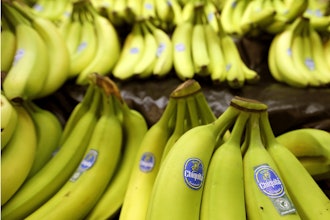
KANSAS CITY, MO — USDA’s National Institute of Food and Agriculture (NIFA) recently awarded 12 grants totaling over $45 million for research to combat Huanglongbing (HLB), commonly known as citrus greening disease.
“USDA-NIFA’s Emergency Citrus Disease Research & Extension (ECDRE) program brings the nation’s top scientists together to tackle this problem,” said Parag Chitnis, NIFA’s acting director. “This research is critical to help farmers find scientifically sound solutions to citrus greening so they can continue to grow citrus crops in a financially sustainable way. We hope this latest round of grant support moves us closer to a viable solution.”
Although citrus greening is a serious threat to the citrus industry worldwide, significant progress has been made to coordinate a multipronged approach for citrus greening management and suppression of the Asian citrus psyllid, an insect that carries and spreads HLB, through expanding partnerships with USDA’s Animal and Plant Health inspection Service, states, universities, and private partners. Here is the list of the 12 ECDRE grants funded by NIFA in this FY2020 release:
- The Regents of University of California, Riverside, for the project, “Novel, Non-Transgenic, Hybrid Citrus Varieties with Resistance to Huanglongbing: Evaluation and Cultivar Development” ($4,670,000)
- University of California, Davis, for the project, “VIGS-Driven RNAI using Insect Specific Viruses to Manipulate Psyllids and their Endosymbionts as a Strategy to Control Citrus Greening/HLB” ($1,411,605)
- University of California, Riverside, for the project, “CAP: Combining Cultural and Genetic Approaches for Grove Success to Unravel and Enhance Resistance/Tolerance to Huanglongbing” ($6,500,000)
- Yale University, New Haven, Connecticut, for the project, “SP: Identification of HLB Susceptibility Genes in a Citrus Population Generated using Multiplexed CRISPR/CAS9 Gene Editing” ($1,497,644)
- Citrus Research & Development Foundation, Lake Alfred, Florida, for the project, “CAP Collaborative Approach Between Academics, Growers and Agrochemical Industry to Discover, Develop and Commercialize Therapies for Citrus Huanglongbing (HLB)” ($10,071,000)
- University of Florida, Gainesville, for the project, “SP: Optimal BT Toxins and Gene Silencing RNAs for Management of Asian Citrus Psyllid to Mitigate the Impact of Citrus Greening” ($1,480,456)
- University of Florida, Gainesville, for the project, “SP: A Novel Therapeutic Strategy for HLB-Infected Trees” ($1,473,890)
- University of Florida, Gainesville, for the project, “SP-Unraveling Candidatus Liberibacter Asiaticus-Phloem Interactions using Isolated Vasculature from Seed Coats” ($1,496,707)
- University of Maryland, College Park, for the project, “Phloem Targeted Multiplexed Gene Editing for Enhanced Control of Huanglongbing in Citrus” ($942,906)
- University of Maryland, College Park, for the project, “SP: Phloem-Restricted, Independently Mobile RNA Gene Silencing System for Mitigating Citrus Greening by Targeting Liberibacter Asiaticus and Citrus Gene Expression” ($1,500,000)
- USDA-ARS, Genetics and Precision Agriculture Unit, Mississippi State, for the project, “CAP: Therapeutic Molecule Evaluation and Field Delivery Pipeline for Solutions to HLB” ($9,380,000)
- NMC, Inc., Los Alamos, New Mexico, for the project, “Providing Practical Solutions for HLB Treatment and Prevention” ($4,759,531)
NIFA-funded programs support multiple themes outlined in the USDA Science Blueprint and move us closer to meeting the goals outlined in USDA’s Agriculture Innovation Agenda. ### USDA is an equal opportunity provider, employer, and lender.
Background: The insect that transmits citrus greening is the Asian citrus psyllid, which acquires the presumed causal agent, Ca. Liberibacter asiaticus, by feeding on an infected citrus plant and subsequently transmitting the bacterium to healthy citrus trees, also during feeding. Asian citrus psyllid was first detected in Florida in 1998, and by 2005 it had spread to all 32 citrus-producing counties. Since its discovery in Florida, the industry has lost 60 percent of acreage with about 80 percent closure of juice plants and packinghouses. In 2012, citrus greening was confirmed in an orange grove in Texas and in a single residential tree in California that was immediately removed. In 2019, the California Department of Food and Agriculture confirmed 1,508 trees in three counties were infected with HLB.
Successful citrus greening management is difficult once the disease is established. Limited disease tolerance was identified in some available commercial citrus scion and newly released rootstock varieties. Growers are increasing the use of these new scions and rootstocks in new plantings. Areawide Asian citrus psyllid suppression is essential to disease prevention and management, coupled with accurate diagnosis of diseased trees, removal of infected trees (on a voluntary basis), and replacement with young trees certified to be free of known pathogens.
The overarching goals and desired outcomes for the ECDRE program are: to combat HLB and its disease complex in order to continue to be able to farm citrus in a financially sustainable way through collaborative approaches and knowledge; transition from component-focused research to deploying research outcomes and conclusions on farms; and encourage research teams to bring knowledge together to find grower solutions to combat and prevent HLB infection.
NIFA’s ECDRE program aims to address these needs through the promotion of collaboration, open communication, the exchange of information, and the development of resources that accelerate application of scientific discovery and technology to farm-level solutions for HLB.






















